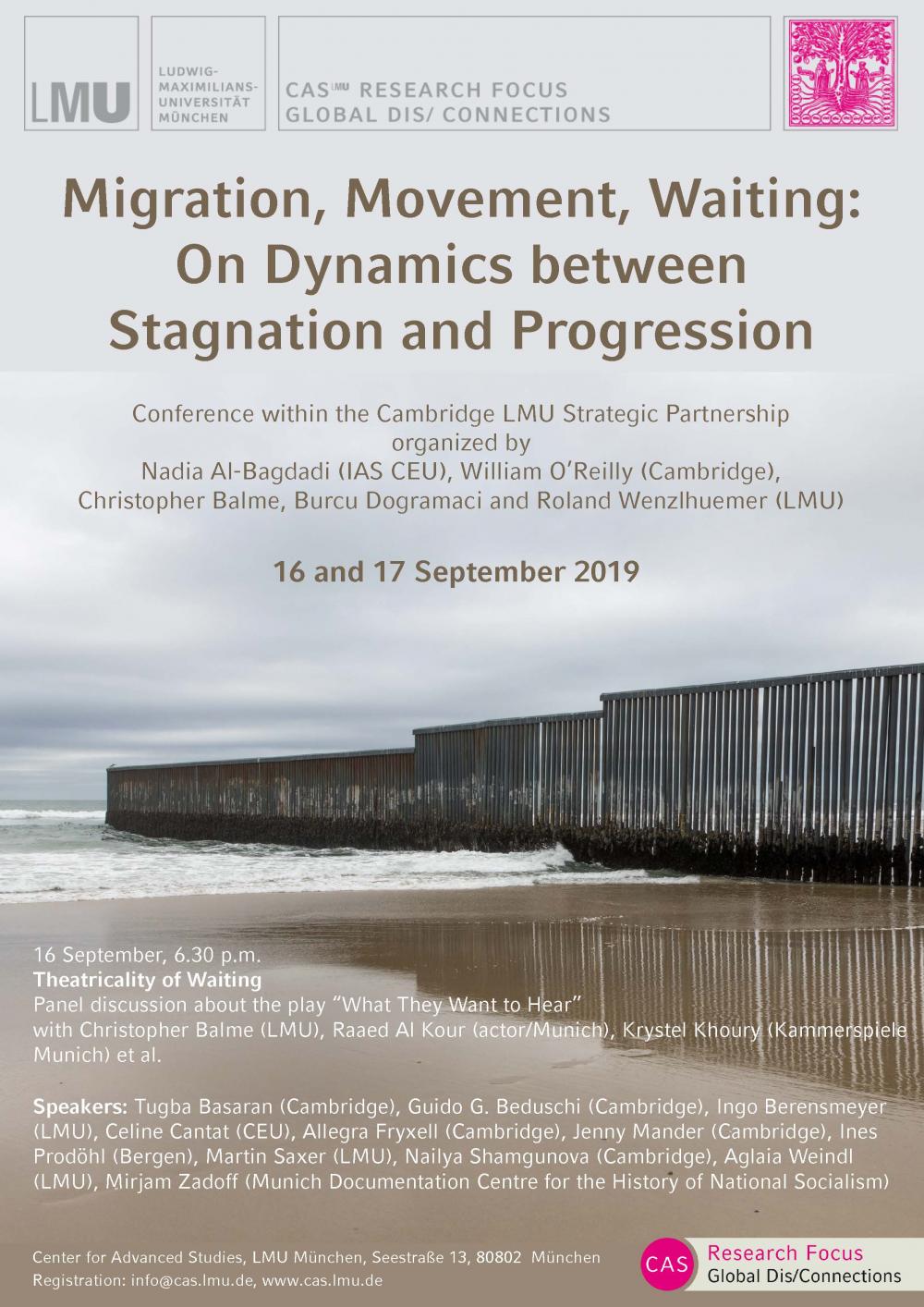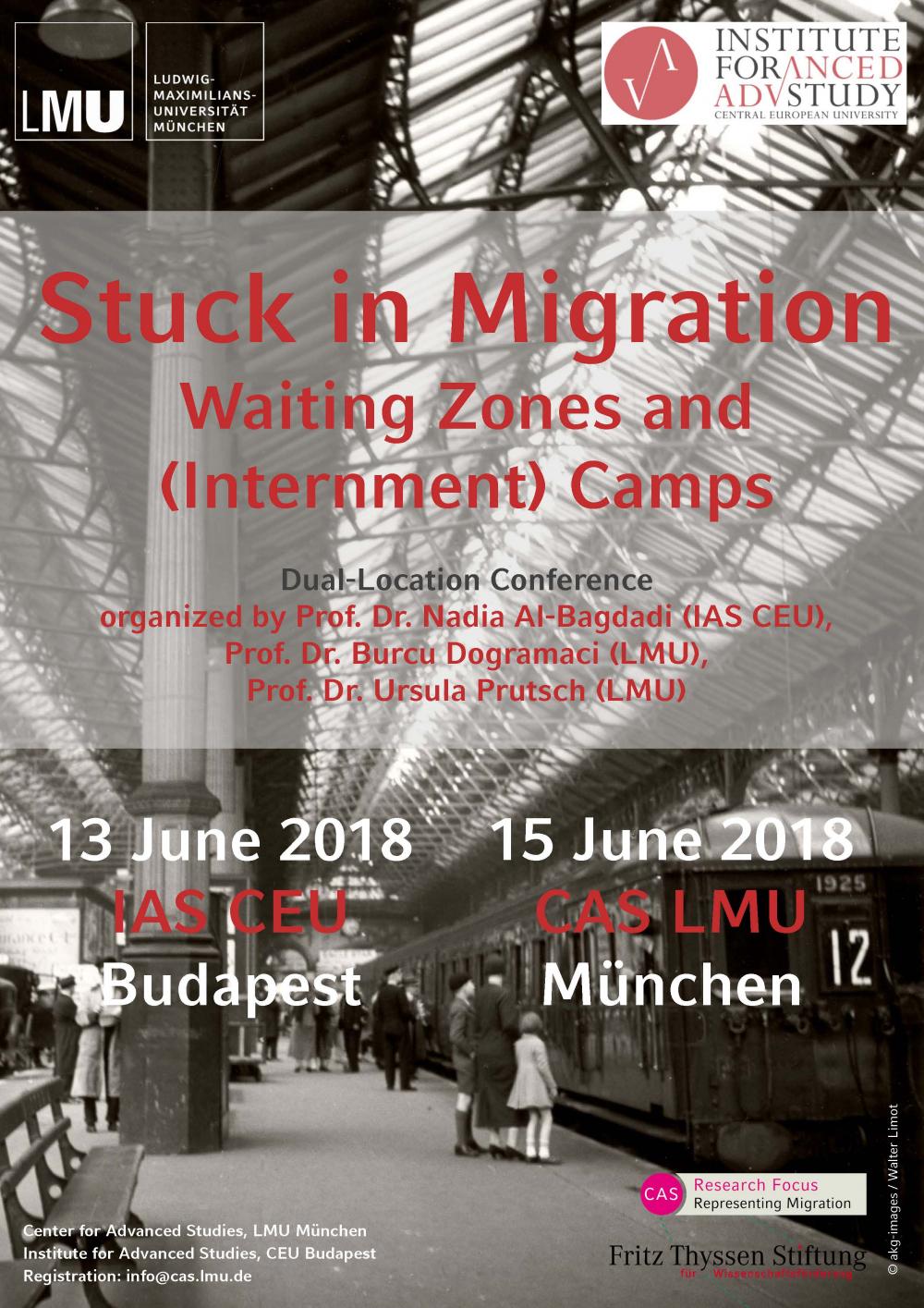On the State of Waiting

PI: Dr William O’Reilly
Grant support: Cambridge-LMU Strategic Partnership Grant;
Cambridge Humanities Research Grant;
Center for Advanced Study, Ludwig-Maximilians University Munich;
Institute of Advanced Study, Central European University, Budapest
The Centre for the Study of Global Human Movement, Cambridge
Waiting is not only a particular experience of time, but as Bourdieu put it, waiting is a way of experiencing the effect of power. ‘Making people wait… delaying without destroying hope is part of the domination’ (Bourdieu, 2000). To keep people waiting is an exercise of power, a manipulation of other people’s time where people are kept in uncertainty, kept in the dark as they are kept ignorant as to how long they must wait. Being subject to waiting, which is essential to migratory processes, is also a common experience for all less-powerful groups in society, producing subjective effects of dependency and subordination. Waiting generates feelings of powerlessness and vulnerability and a feeling that one is not fully in command of one’s life. It degrades the individual, one’s own time and social worth in relation to the one who imposes the wait.
There is a political economy of waiting, too. Migrants have always been subjected to waiting and there is a dominant view of waiting as empty, devalued and wasted time, which results in a feeling of uselessness, that we see very much in play vis-à-vis migrants. This waste of time that devalues the person is predicated upon migrants’ spatial immobility.
E.P. Thomspon wrote that the emptiness and uselessness attributed to the ‘wasted time’ of waiting, is rooted in the value placed by the capitalist system on productive labour, where time as quantified and commoditized within the time-discipline, predicated on the objectives of efficiency of the labour force and on the avoidance and aversion of idleness. Time, according to Thompson, thus became currency and was ‘spent’ rather than ‘passed’. The enduring result of this shift is that waiting, in Western contexts, is seen as undesirable, unproductive and wasteful and most importantly waiting is seen as an inactivity as it is not productive.

E.P. Thomspon wrote that the emptiness and uselessness attributed to the ‘wasted time’ of waiting, is rooted in the value placed by the capitalist system on productive labour, where time as quantified and commoditized within the time-discipline, predicated on the objectives of efficiency of the labour force and on the avoidance and aversion of idleness. Time, according to Thompson, thus became currency and was ‘spent’ rather than ‘passed’. The enduring result of this shift is that waiting, in Western contexts, is seen as undesirable, unproductive and wasteful and most importantly waiting is seen as an inactivity as it is not productive.
This project seeks to consider Waiting as a state of time and an aspect of political economy in the western tradition since the late fifteenth century. Work to-date has focussed on the state of Waiting in the history of movement and migration. Movement may be the more well-known face of migration but waiting and immobility have shaped as intensely experiences of passage, in the past as well as in the present. This project inquires into waiting in its conceptual, empirical, affectional and emotional components, including:
Barriers, fences and borders in Europe force many prospective migrants to lead lives in suspension, a state of waiting, not knowing when the moment of departure will be, if it will ever arrive. Waiting determines the everyday lives of many refugees and migrants, awaiting permissions, authorizations in an effort to move from one place to another, but also enclosure from a repetitive present to the future.

As such, Waiting is interested in exploring waiting and:
- Its deployment as a way of governing societies and economies;
- Its relation to capitalism, labour, idleness and productivity;
- Its relation to the politics of scales (local, national and global);
- The fluidity of boundaries and interactions between movement and waiting;
- The experiences of waiting, its affects and effects;
- Attributes and implications of waiting for conceptions of self and society;
- Its uses in the politics of refugee, migration and crises as enforced waiting;
- Techniques and technologies of waiting, including legal borders and smart borders;
- Hospitality, hostility and flight; suspension in time and space;
- Teleology of movement and waiting in politics of migration; denial of coevalness
The project has held two international conferences and two PhD workshops, at Budapest, Munich and Cambridge. The first took place on 13-15 June 2018 at Budapest and Munich and full details of the ‘Stuck in Migration. Waiting Zones and Internment Camps’ conference can be found here:
https://ias.ceu.edu/events/2018-06-13/stuck-migration-waiting-zones-and-internment-camps
and
https://www.uni-muenchen.de/forschung/news/2018/cas_tagung_migration.html
A related international conference had also taken place on 27 March 2018, and details can be found here:
A doctoral workshop was held at Cambridge on 1-3 July 2019, with a follow-up workshop in Munich on 16-17 September 2019. A report on that workshop can be found here:
https://www.hsozkult.de/event/id/termine-41154
and
A collection of essays, edited by William O’Reilly and Nadia Al-Baghdadi, will be published by Bloomsbury in 2021 with the title Stuck in Migration: Mobility and Immobility in Perspective, which has grown from the conferences mentioned above, addresses the curiously neglected connection between the state of waiting and the dynamics of migration and movement brought together international scholars from a range of disciplinary backgrounds who focussed on the question of motion and migration and their antonyms, immobility and waiting. In our conferences, scholars approached and discussed the connection between migration and waiting from an historical, sociological, legal and anthropological perspective, as well as in the context of the arts and visual studies, scholars offers an overarchingly global and historical perspective on the concept of being Stuck in Migration.
The initial prompt for this project was the situation that arose in the summer of 2015 which physically and politically linked the two cities of Budapest and Munich – the movement of some one million people through their cities en route to news lives in Germany and elsewhere in Europe. The reality of life that summer and thereafter for the vast majority of people on the move was that movement was punctuated, often against the will of those people moving, by protracted periods of time spend waiting, stuck at borders, at rail stations, at border and customs checkpoints where entry was denied; or at transit points where access to transportation was denied or was delayed. These places, where people were ‘stuck in migration’ were affected, just as the very people considered to be on the move were affected, too. In Budapest, the Keleti Station became a symbol of forced migration, of civil engagement support, and of political opposition at one and the same time. The broader sociological, demographical, anthropological and cultural implications of mobility and immobility brought about by this crisis required a rethinking of the meaning of being stuck in migration for bureaucrats and governments, for aid agencies and for scholars, too.
Barriers, fences and borders in Europe forced and still force many prospective migrants to lead lives in suspension, in a state of waiting and not knowing when the moment of departure would be, if it would ever arrive. Being Stuck in Migration, waiting, determines the everyday lives of many refugees and migrants, awaiting permissions and authorizations in an effort to move from one place to another. Movement may be the more well-known face of migration but waiting and immobility have shaped experiences of passage just as intensely, in the past as well as in the present. Stuck in Migration is a multi-disciplinary study of the idea of ‘stuckedness’, of ‘waiting’, and of ‘in-betweenedness’ and of resting places in the history of migration.
In a series of chapters by historians, sociologists, literary scholars, by scholars of gender studies, film and more, Stuck in Migration looks at the physical and conceptual sites of ‘stuckedness’, including quaysides, riverbanks, ships, boats, lazarets, railway stations, and border camps, which are located at the interface of speed and politics and which function by controlling those who are forced into and through them. It also looks at the legal, governmental and extra-governmental systems which have, historically, and which continue today politically, to construct and maintain these sites of control. Accession to movement is generally seen as a mark of contemporary civil rights and those who are forced to wait, whose trajectory of movement is punctuated by the slowing down of political agency, experience modernity in a different way.
Waiting spaces and ‘stuckedness’ have been impacted upon by the technologies of travel and the bureaucracy of the state. From the imposition of sanitary and ‘hygiene’ controls on eastern European migrants in western European and American ports, to the detention of post-World War I migrants in railway carriages and stations, to the emergence of the detention camp; the number and scale of waiting places, detaining migrants in time and space, increased as the state has come to control borders, leaving some to spend their entire lives, and sometimes generations, stuck in migration. Will this continue into the twenty-first century and beyond?
To explore these themes, Stuck in Migration: Mobility and Immobility in Perspective presents ten chapters which look at migration history as a history of waiting; at artistic and literary reflections on waiting; at migration and regional and global demographic challenges; at the invisible and visible traces of waiting in the arrival cities of migration: anthropological perspectives; and at architectures of waiting and urban landscapes of flight.
